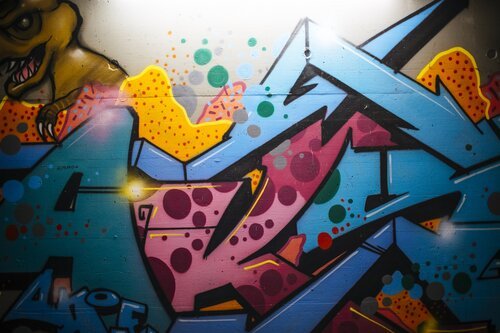How do I start graffiti art? First Step Guide / What materials are used for graffiti?
Graffiti art work is a vibrant and expressive form of self-expression that has captured the imagination of many aspiring artists. Two common questions from new artists are, “ How do I start graffiti art? First Step Guide, What materials are used for graffiti?” and we’ll be answering both of those here. If you're intrigued by the world of graffiti and eager to dive into this art form, you might be wondering where to begin. In this blog post, we will explore legal methods for practicing graffiti, including sketching in a black book, painting legal walls, or experimenting with digital tools.
Supplies
Pencils
You don’t need anything fancy here, any pencil around your house will do just fine but if you’re interested in quality pencils, I happen to like Faber Castell’s pencils.
Outline Pens
The Sakura Pigma Micron provides great and easy control with a monoline nib so you get a uniform width on every stroke. These are easy for new artists to use but just as suitable for pro artists.
The Pentel Fude Brush Pen is the only tool I ever outline with, I love this thing and can’t recommend it enough. I will say, for newer artists or artists who aren’t used to pressure-sensitive tools, this can be hard to control. If you can manage to control it then you’ll have tons of control over your line width. This can make your art more dynamic and versatile.
Markers
I want to start this section off by saying you do not need expensive or premium markers when starting out. Understand, the supplies won’t make your art better, they only augment your current skill. Many new artists spend a fortune on expensive markers that do little for them. Sharpies and other cheaper options work just fine for new artists. With that said, prisma markers are a great option for anyone who wants some quality markers. These arent by any means the best of the best but they are affordable and they work amazingly for even pro-level artists work.
Side note, many new graffiti artists like to use paint markers (Prismacolor is alcohol based) for their graffiti, however, these types of markers are much rougher. Their course nib tends to rip into paper and the paint itself also crumples thinner paper as the paint dries. While you certainly could use paint markers in sketchbooks, it’s not really advised unless you use them very sparingly or you prep the page with gesso before painting with the marker.
Sketchbooks
Bachmore 8.5” x 11” sketchbook is a great starting option. The paper is what you’d expect out of a sketchbook and it works. Reliable standard sketchbook.
The Canson XL Series Watercolor paper is much sturdier. I personally love to do graffiti on watercolor paper because the paper absorbs and holds the ink better than a lot of thinner paper out there. This is a personal preference though so not everyone will enjoy thicker textured paper.
Spray Paint, Tag Markers
There are plenty of amazing brands of spray paint out there, so for this section, I’ll recommend two graffiti online stores that just about all graffiti artists shop at.
Each of these graffiti shops online will have all the spray paint, caps, and markers you need. Since each brand of paint has plenty of artists who swear by the quality you’ll have to test different cans out to see the one you like most. I happen to like Flame, and MTN Gold. A common question is “ what is the best spray paint for art?” Fun side note, I have friends in some of these brands and they’ve told me how many of the brands are the exact same paint, just different wrappers. The reason is that many of these companies use the same manufacturer. For that reason, preference might come down to color selection rather than quality. Many of these brands have amazing quality so that shouldn’t be an issue. Feel free to watch this video we made on how to use spray paint.
Digital Graffiti
For artists who enjoy working digitally, exploring digital graffiti opens up a whole new world of possibilities. Digital tools offer flexibility, unlimited color options, and the ability to experiment without limitations. If you're using Procreate, we highly recommend checking out our Graffiti Flair Brush Pack. These custom brushes are specifically designed to emulate the texture and style of graffiti art, allowing you to create stunning digital graffiti pieces.
2:Picking a Tag Name / Sketching in a Blackbook
I made a whole playlist that teaches you everything you need to know about graffiti. Watch our video on that here.
One of the best ways to start your graffiti journey is by sketching in a black book. A black book is essentially a graffiti artist's personal sketchbook where they can learn the basics of graffiti and experiment with different lettering styles, and concepts. It allows you to practice and refine your skills in a controlled environment and also gives you a place to play around without the concern of quality. While in the beginning, a cheap sketchpad will work just fine, if you find you want to try new mediums, invest in a good quality black book, with pages that can handle different drawing media such as markers, pens, and colored pencils.
First step is to pick a tag and practice it. Most graffiti artists change their tag name after a few years, this first name serves as training wheels until you’re comfortable with the basics. For that reason, don’t obsess over picking the perfect name right from the start. Normally, focusing on finding the absolute perfect name right from the start causes people to never begin at all. With that said, here are some tips to finding a decent first name.
Write out the alphabet, circle the letters you really like, and write those letters down. If you’d like, select another batch of letters you’re only sort of fond of. Take these letters and make a list of names that are between 3-7 letters. Longer and shorter names are possible, but 3-7 is the norm in graffiti. From here, play around with each name on your list and to see what one you enjoy. When playing with the name, focus on whether or not you like the name in general, dont disregard the name because you think “it doesn’t flow, or its hard”. The observations you make about the name’s fundamentals or difficulties are going to be wrong since you dont yet know the basics to make accurate judgments about any name. Trust me, as you learn you’ll find all names are good in the right hands, so your job will be to learn whatever name you choose.
Let’s create a graffiti tag, its easy, but only if we have a clear game plan, let me explain. Separate your fun, playful drawings from your studies. When drawing for fun don’t worry one bit about quality, just focus on having a good time. When drawing for practice you will keep your work simple and without style so you can learn the basics. Start by studying basic letter structures. Understanding the foundational structure of letters is crucial for developing your own unique graffiti later down the line. By mastering the basics, you'll have a solid foundation to build upon and create more intricate and captivating designs. Keep your tags simple and devoid of complex styles.
Devote practice sessions to basic shapes and lines. Working on basic shapes, such as circles, squares, triangles, and rectangles, helps you get cleaner letters for all forms of graffiti. Concentrate on achieving clean and smooth lines, practicing various line weights, and experimenting with shading techniques. This will ensure that your tags, throwies, and pieces are crisp and well-defined, free from any unintended sloppiness. With all that said, remember, your sketchbook is a space for experimentation and growth. So grab your markers, pens, and pencils, and let your sketchbook be the playground where your graffiti art evolves and thrives. Visit our graffiti online store for tutorial E-Books.
3: Painting Legal Walls
Painting legal walls is a responsible and legal way to express and practice your graffiti artistry. Many cities have designated areas or walls where graffiti artists can showcase their talent without breaking the law. Check with your local municipality or organizations that promote street art to find out about legal wall locations in your area. Painting legal walls provides a platform for you to connect with other artists, gain exposure, and contribute to the urban art scene in a positive way. Now if you’re struggling to find legal walls you can always make your own. You don’t need a whole brick wall, or anything fancy, you can grab a plastic wrap and create a makeshift wall that way, or you can use cardboard too! Check out this video for suggestions on how to practice spray paint if you don’t have legal walls.
4: Valuable Resources at Our Store
To further support your journey into graffiti art, we offer a range of informative e-books that cover various aspects of the art form. These e-books provide valuable insights into techniques, and styles of graffiti, along with practical tips and step-by-step tutorials. Whether you're a beginner or an experienced artist, our e-books can help you refine your skills, explore new approaches, and gain inspiration from renowned graffiti artists worldwide. Visit our store and browse our collection to find resources that suit your interests and goals.
Conclusion
Embarking on a graffiti art journey can be an exciting and fulfilling experience. Remember to start by sketching in a black book, honing your skills, and developing your style. Explore legal wall opportunities in your area to showcase your work and contribute positively to the urban art scene. If you prefer working digitally, unleash your creativity with the help of our Graffiti Flair Brush Pack for Procreate. And don't forget to take advantage of the valuable resources available at our store, including informative e-books that can inspire and guide you on your graffiti art path. Embrace this expressive art form, enjoy the process, and let your creativity thrive.








